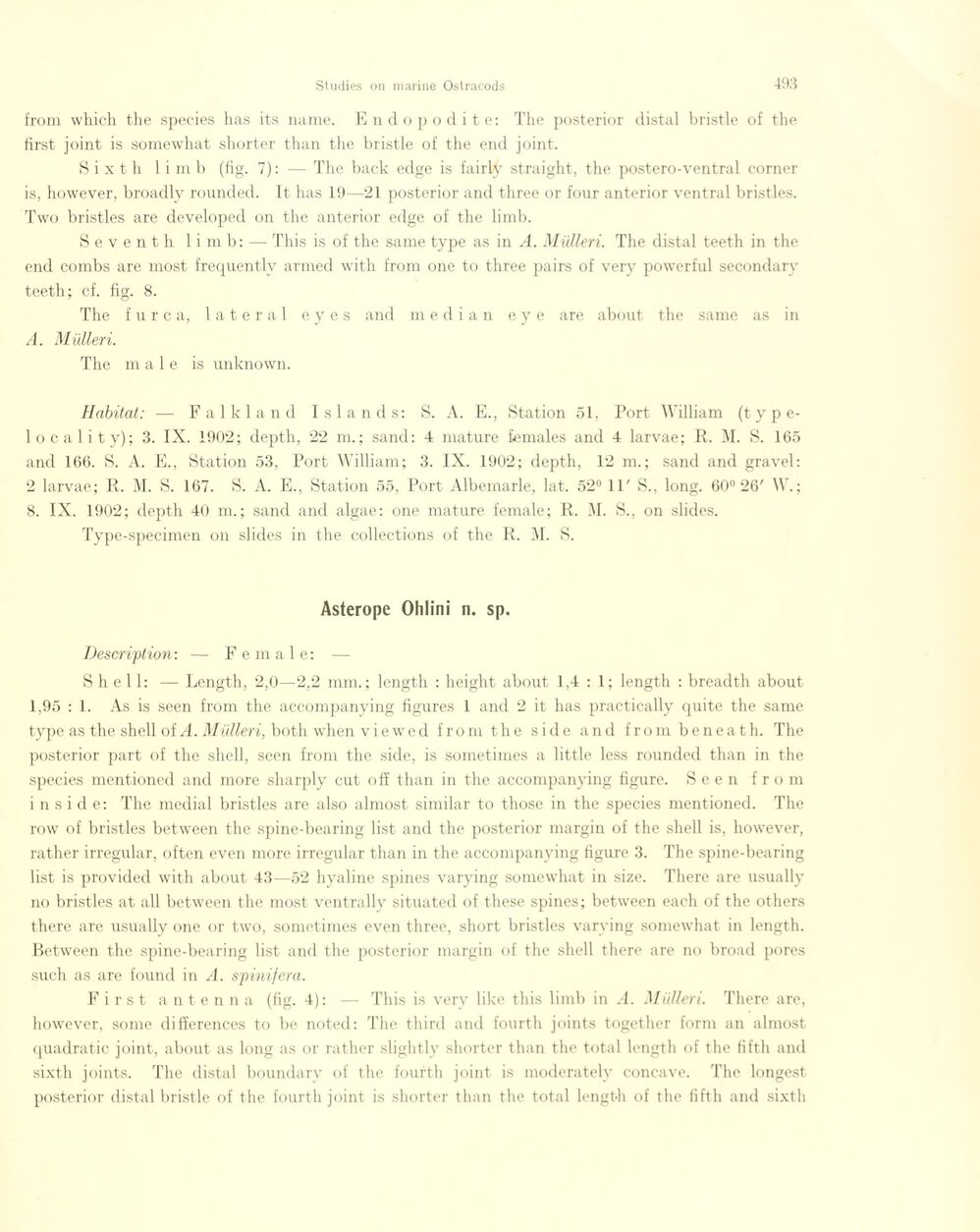
Full resolution (JPEG) - On this page / på denna sida - Sidor ...

<< prev. page << föreg. sida << >> nästa sida >> next page >>
Below is the raw OCR text
from the above scanned image.
Do you see an error? Proofread the page now!
Här nedan syns maskintolkade texten från faksimilbilden ovan.
Ser du något fel? Korrekturläs sidan nu!
This page has never been proofread. / Denna sida har aldrig korrekturlästs.
from which the species has its name. Endopoclite: The posterior distal bristle of the
first joint is somewhat shorter than the bristle of the end joint.
Sixth li mb (fig. 7): — The back edge is fairly straight, the postero-ventral corner
is, however, broaclly rounded. It has 19—21 posterior and three or four anterior ventral bristles.
Two bristles are developed on the anterior edge of the limb.
S e v e n t h limb: — This is of the same type as in A. Mulleri. The distal teeth in the
end combs are most frequently armed with from one to three pairs of very powerful secondary
teeth; cf. fig. 8.
The furca, lateral eyes and median e y e are about the same as in
A. Muller i.
The male is unknown.
Habitat: — Falkland Islands: S. A. E., Station 51, Port William
(type-locality); 3. IX. 1902; depth, 22 m.; sand: 4 mature females and 4 larvae; R. M. S. 165
and 166. S. A. E., Station 53, Port William; 3. IX. 1902; depth, 12 m.; sand and gravel:
2 larvae; R. M. S. 167. S. A. E., Station 55, Port Albemarle, lat. 52° 11’ S., long. 60° 26’ W. ;
8. IX. 1902; depth 40 m.; sand and algae: one mature female; R. M. S., on slides.
Type-specimen on slides in the collections of the R. M. S.
Asterope Ohlini n. sp.
Description-. — Female: —
Shell: — Length, 2,0—2,2 mm.; length : lieight about 1,4 : 1; length : breadth about
1,95 : 1. As is seen from the accompanying figures 1 and 2 it has practically quite the same
type as the shell of A. Mulleri, both when v i e w e d from the side and from b e n e a t h. The
posterior part of the shell, seen from the side, is sometiines a little less rounded than in the
species mentioned and more sharply cut o ff than in the accompanying figure. Seen from
inside: The medial bristles are also almost similar to those in the species mentioned. The
row of bristles between the spine-bearing list and the posterior margin of the shell is, however,
rather irregulär, often even more irregulär than in the accompanying figure 3. The spine-bearing
list is provided with about 43—52 hyaline spines varying somewhat in size. There are usually
no bristles at all between the most ventrally situated of these spines; between cach of the others
there are usually one or two, sometimes even three, short bristles varying somewhat in length.
Between the spine-bearing list and the posterior margin of the shell there are no broad pores
such as are found in A. spinifera.
First antenna (fig. 4): — This is very like this limb in A. Miilleri. There are,
however, some differences to be noted: The third and fourth joints together form an almost
quadratic joint, about as long as or rather slightlv shorter than the total length of the fiftli and
sixth joints. The distal boundary of the fourth joint is moderately concave. The longest
posterior distal bristle of the fourth joint is shorter than the total length of the fiftli and sixth
<< prev. page << föreg. sida << >> nästa sida >> next page >>